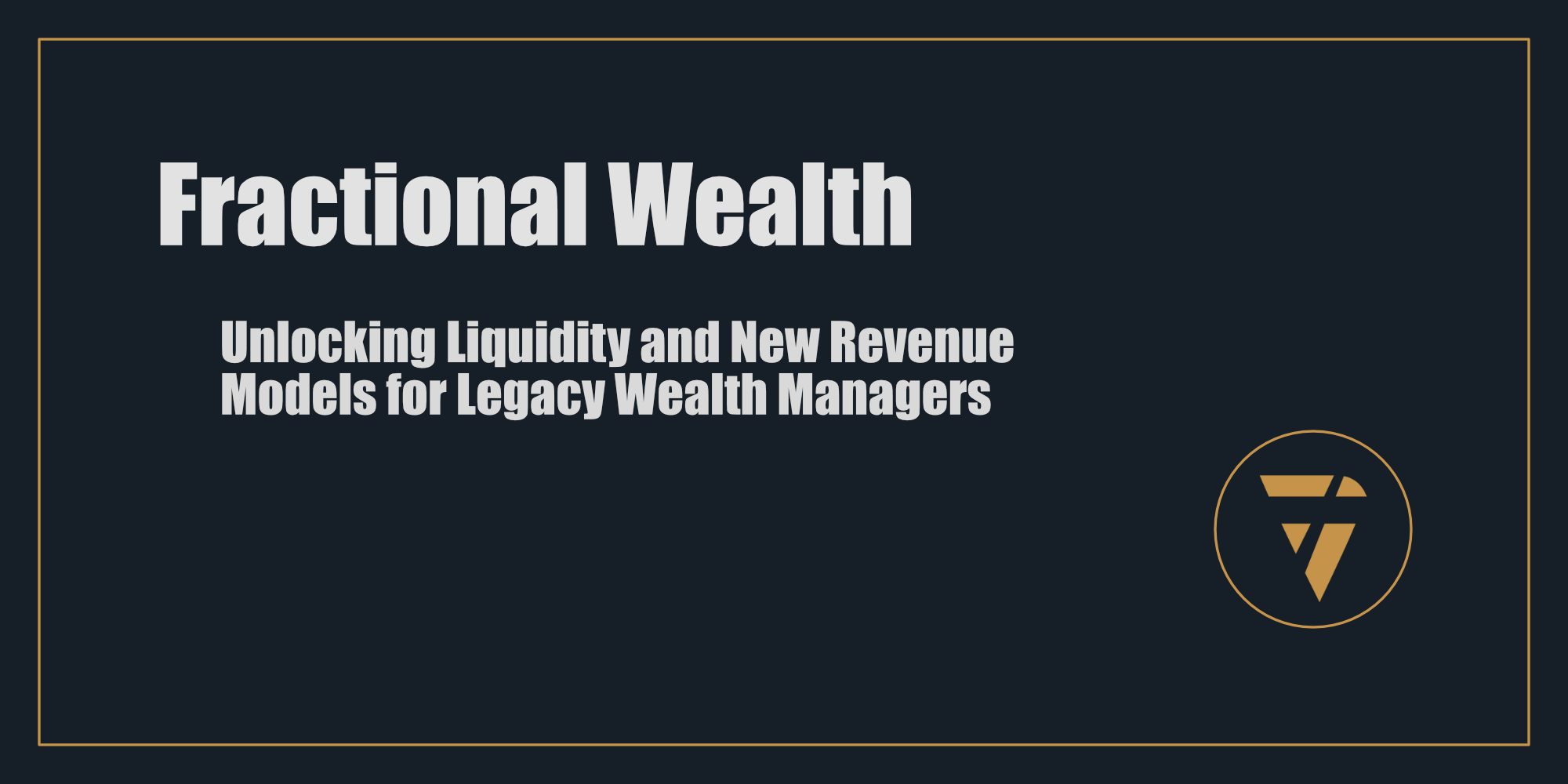Fractional Wealth
Unlocking Liquidity and New Revenue Models for Legacy Wealth Managers

What Got You Here Won’t Get You There
For decades, the wealth management industry has been defined by its ability to navigate clients through turbulent markets, preserve generational wealth, and deliver steady returns. Yet today, this traditional model is under siege, not from obsolescence, but from transformation. In a world reshaped by blockchain technology, democratized investment opportunities, and increasingly sophisticated client expectations, wealth managers must ask themselves a hard question: Are we adapting fast enough to stay relevant?
The answer, for many, lies in a bold new frontier: fractional wealth and tokenized assets.
Fractional Wealth: More Than Just a Buzzword
At its core, fractional wealth represents the ability to divide high-value, traditionally illiquid assets—such as real estate, fine art, or private equity—into smaller, more accessible units. Tokenization, powered by blockchain, elevates this concept, enabling seamless digital transactions, enhanced transparency, and secure ownership. For clients, it means access to a broader array of investments. For wealth managers, it signals new revenue streams, deeper client engagement, and a chance to lead in a rapidly evolving landscape.
But this is more than a technological shift. It’s a redefinition of how wealth can be managed, grown, and utilized.
The Opportunity Hidden in the Problem
Wealth managers face growing pressure to:
- Meet Client Expectations: High-net-worth individuals (HNWIs) and next-generation investors want more than portfolios that preserve wealth. They want investments that reflect their values, offer liquidity, and provide access to exclusive opportunities.
- Innovate Without Overextending: How can firms adopt cutting-edge solutions without risking their established operations or client trust?
- Differentiate in a Crowded Market: With the proliferation of robo-advisors and direct-to-consumer platforms, the value proposition for wealth managers has never been more critical, or more scrutinized.
Fractional ownership offers solutions to these challenges by transforming illiquid assets into flexible, tradable instruments that can diversify portfolios, unlock value, and attract a new wave of clients.
How Fractional Wealth Works
Imagine this scenario: A client wishes to invest in luxury real estate but lacks the capital—or the desire—to own an entire property outright. Through fractional ownership, that client can purchase a tokenized portion of a property, gaining the benefits of appreciation, rental income, and diversified exposure.
Similarly, consider fine art. Tokenization allows clients to hold fractional shares in a $10 million painting. The blockchain not only ensures their ownership is secure but also provides them the liquidity to sell their stake on secondary markets.
This isn't speculative. The infrastructure is already here, and early adopters are reaping the rewards.
The Strategic Benefits for Wealth Managers
New Revenue Streams:
Transaction fees for fractional asset trades.
Management fees for curating tokenized investment opportunities.
Cross-selling opportunities as fractional offerings attract new client demographics.
Enhanced Client Retention:
Meeting next-gen client demands for transparency, accessibility, and ESG-aligned investments.
Offering personalized, innovative solutions that deepen trust and loyalty.
First-Mover Advantage:
Differentiation in a competitive landscape.
Establishing your firm as a leader in wealth tech and innovation.
Case Studies: Success Stories in Fractional Wealth
1. Real Estate Tokenization in Dubai:
A luxury apartment complex in Dubai was tokenized, allowing investors to purchase fractional shares for as little as $10,000. Within weeks, the project was oversubscribed, demonstrating the demand for accessible real estate opportunities in emerging markets.
2. Fine Art Fractionalization:
A major auction house partnered with a blockchain firm to tokenize blue-chip art, enabling investors to hold stakes in works by Picasso and Warhol. The program attracted not only HNWIs but also younger investors eager for exposure to high-value collectibles.
The Challenges Ahead
As with any innovation, fractional wealth comes with hurdles:
- Regulatory Complexity: Compliance varies by jurisdiction, requiring careful navigation.
- Client Education: Fractional ownership is a new concept for many clients. Managers must simplify the narrative without compromising on sophistication.
- Operational Integration: Implementing tokenized systems requires technological investment and robust cybersecurity.
Action Steps for Wealth Managers
Educate Yourself and Your Team:
Familiarize your firm with blockchain and tokenization technologies.
Host workshops to explore use cases and implications for your practice.
Build Strategic Partnerships:
Collaborate with fintech platforms specializing in fractional ownership.
Partner with blockchain experts to ensure secure and compliant implementation.
Create a Phased Adoption Plan:
Start small with select clients or a pilot program.
Gradually expand offerings based on market demand and client feedback.
Focus on Communication:
Develop clear, client-friendly materials that explain the benefits and risks of fractional wealth.
Use storytelling to illustrate how these solutions align with client goals.
The Road Ahead
Fractional wealth isn’t just a passing trend, it’s the future of wealth management. As clients increasingly demand access, flexibility, and innovation, wealth managers who embrace these models will position themselves as indispensable partners in a new era of finance.
The choice is clear: adapt and thrive, or cling to legacy models and risk irrelevance. The era of fractional wealth is here. Will you seize the opportunity?
Key Takeaways
- Fractional wealth unlocks new possibilities for diversification, liquidity, and client engagement.
- Tokenization is a transformative tool that can modernize legacy wealth management practices.
- By acting now, wealth managers can establish themselves as leaders in this emerging space.
Join the Conversation
How are you preparing to integrate fractional assets into your practice? Share your thoughts and questions and explore how fractional wealth can transform your business.
This Substack is reader-supported. To receive new posts and support my work, consider becoming a free or paid subscriber.
This is what I’m working on. Tell me what you think, I enjoy the conversation! Subscribe and follow the work in real time.
Thanks!
B
Fractional wealth is more than innovation, it’s evolution. Illiquid assets like real estate and art are now accessible, tradable, and democratized. Will you adapt to this seismic shift, or watch as your clients move toward the future without you?
PS -





